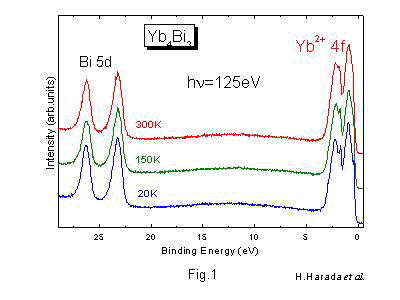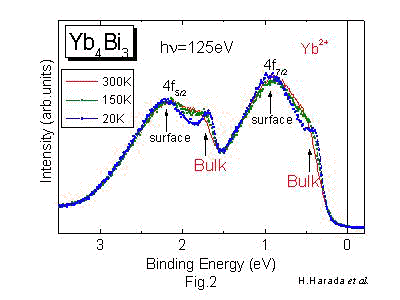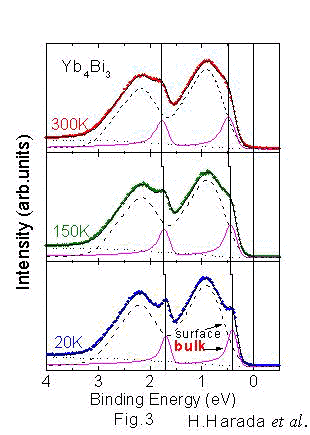Photoemission Study of Yb4Bi3:
Unusual temperature dependence of the bulk Yb 4f spectra
(Collaborating with Prof. A. Ochiai in
Tohoku University and Prof. H. Harima in Osaka University)
Journal of Physical Society
of Japan vol.68, p.2844 (1999).
We have performed a photoemission
study of Yb4Bi3. The
valence band spectra taken at hν = 125 eV have shown no multiplet structures associated
with the trivalent Yb and revealed that the mean valence of the Yb ion is very close to 2.0. The divalent Yb 4f spectra have shown strong surface
components besides weak but sharp bulk components. The surface
4f level shift is about 0.45 eV (300 K), 0.48 eV (150 K) and
0.54 (20 K). A clear energy shift of the bulk Yb 4f peaks
toward EF with decreasing temperature has been observed,
although Yb4Bi3 shows neither phase transition
nor crossover. Such an unusual peak shift of the bulk component
may originate from a change of the lattice constant with decreasing
temperature. The observed narrowing of the bulk 4f peaks is thought
to be due to a phonon broadening (about 7kBT).
Introduction
We have studied electronic structures of anti-Th3P4 type
crystal Yb4Bi3 in comparison with Yb4As3. Yb4As3 is an
interesting material because of its unusual physical
properties. It undergoes a structural phase transition from a
valence fluctuating (VF) state with a cubic phase to a charge
ordered (CO) state with a trigonal phase at Tt~290K. The
photoemission studies of Yb4As3 and Yb4(As1-xSbx)3 have been
previously reported, where the spectra have shown remarkable
temperature dependence resulting from the VF-CO transition [S. Suga et al., J. Phys. Soc. Jpn. vol.67, 3552 (1998).].
Yb4Bi3 has the same crystal structure as the cubic Yb4As3,
but it does not show any phase transition. It is thought that the
Yb 4f electronic state of Yb4Bi3 is different from that of Yb4As3.
From a result of the magnetic susceptibility measurement,
the Yb ions are considered to be close to 2+ (4f14).
In order to investigate the detailed electronic state of Yb4Bi3, we have
measured photoemission spectra of a single crystal Yb4Bi3. In
our spectra, signals of Yb3+ state have not been observed,
indicating that the Yb ions are divalent. Furthermore, the
spectra show an unusual energy shift of the bulk Yb2+ 4f peaks
with changing temperature although Yb4Bi3 does not show any phase transition.
Results and Discussion
Single crystalline Yb4Bi3 was supplied by Prof. A. Ochiai in Tohoku University. The photoemission measurement was done at a
bending magnet beam line BL-3B of the Photon Factory (PF).
The photoemission spectra were measured with using the
SCIENTA SES200 hemispherical analyzer at a photon energy of
hν = 125 eV, where the photoionization cross-section of the Yb 4f
orbitals is approximately one hundred times as large as those of
the Bi 6sp orbitals. The clean surface
was obtained by scraping in situ with using a diamond file.
The total energy resolution was set
to about 90 meV. Temperature dependent spectra were
repeatedly measured and the reproducibility of the spectra was
surely confirmed.
 Figure 1 shows the photoemission spectra in the whole
valence-band region (0-29 eV) of Yb4Bi3 at 20, 150 and 300K. In all spectra, prominent doublet structures due
to the Yb2+ 4f component (4f14->4f13) are observed from EF to 4 eV.
The complex structures are due to mixture of a bulk and a
surface contribution. Bi 5d peaks are observed between 22 and
28 eV. Between Yb2+ 4f and Bi 5d structures, no clear structures
are observed except for a weak and very broad structure in the
wide energy range between 5 and 20 eV. No structures
ascribable to the Yb2+ 4f state is recognized in this region.
One can notice that the satellite and the Bi 5d spectra have no
essential temperature dependence. As for the Yb2+ 4f
components on the other hand, their line shape noticeably
changes with temperature. Judging from Fig.1, it is known that
the Yb2+ ions are dominant in Yb4Bi3.
We conclude that the
mean valence of the Yb ion in Yb4Bi3 is almost 2.0 and that the
Yb ions are not valence fluctuating in contrast to the case of
previously reported Yb4As3.
Figure 1 shows the photoemission spectra in the whole
valence-band region (0-29 eV) of Yb4Bi3 at 20, 150 and 300K. In all spectra, prominent doublet structures due
to the Yb2+ 4f component (4f14->4f13) are observed from EF to 4 eV.
The complex structures are due to mixture of a bulk and a
surface contribution. Bi 5d peaks are observed between 22 and
28 eV. Between Yb2+ 4f and Bi 5d structures, no clear structures
are observed except for a weak and very broad structure in the
wide energy range between 5 and 20 eV. No structures
ascribable to the Yb2+ 4f state is recognized in this region.
One can notice that the satellite and the Bi 5d spectra have no
essential temperature dependence. As for the Yb2+ 4f
components on the other hand, their line shape noticeably
changes with temperature. Judging from Fig.1, it is known that
the Yb2+ ions are dominant in Yb4Bi3.
We conclude that the
mean valence of the Yb ion in Yb4Bi3 is almost 2.0 and that the
Yb ions are not valence fluctuating in contrast to the case of
previously reported Yb4As3.
 Figure 2 shows the spectra of Yb4Bi3 from EF to 3.5 eV. It is noticed that the line shape of the surface
components does not depend much upon the temperature, while
the spectral weight of the bulk components is shifted toward the
Fermi level (EF) with decreasing temperature. The
reproducibility of this behavior has been experimentally
confirmed. In the case of Yb4Bi3 and Yb4(As0.88Sb0.12)3, the peak
energy shift has been observed, however, the shift direction is
towards higher binding energies with decreasing temperature
and the value of the peak shift is about 50meV. As for
Yb4(As0.71Sb0.29)3, which does not show the VF-CO transition,
such a peak shift has not been observed. Since Yb4Bi3 neither
shows any phase transition nor crossover, the observed bulk Yb2+
peak shift is unexpected. Such a phenomenon is, as far as we
know, firstly seen by virtue of temperature regulation and high
energy resolution of the experiment. At the same time, the bulk
Yb2+ contributions become more noticeable at 20K, especially for
the Yb2+ 4f5/2 states, suggesting that narrowing of the peaks
takes place with decreasing temperature in addition to the peak
shift.
Figure 2 shows the spectra of Yb4Bi3 from EF to 3.5 eV. It is noticed that the line shape of the surface
components does not depend much upon the temperature, while
the spectral weight of the bulk components is shifted toward the
Fermi level (EF) with decreasing temperature. The
reproducibility of this behavior has been experimentally
confirmed. In the case of Yb4Bi3 and Yb4(As0.88Sb0.12)3, the peak
energy shift has been observed, however, the shift direction is
towards higher binding energies with decreasing temperature
and the value of the peak shift is about 50meV. As for
Yb4(As0.71Sb0.29)3, which does not show the VF-CO transition,
such a peak shift has not been observed. Since Yb4Bi3 neither
shows any phase transition nor crossover, the observed bulk Yb2+
peak shift is unexpected. Such a phenomenon is, as far as we
know, firstly seen by virtue of temperature regulation and high
energy resolution of the experiment. At the same time, the bulk
Yb2+ contributions become more noticeable at 20K, especially for
the Yb2+ 4f5/2 states, suggesting that narrowing of the peaks
takes place with decreasing temperature in addition to the peak
shift.
 In order to quantitatively discuss the temperature
dependence of the Yb2+ 4f spectra, we have performed the
line-shape analysis using a least-squares fitting. All spectra are
deconvoluted into the line-shapes of the 4f13 bulk and surface
final states, consisting of the 4f7/2 and 4f5/2 doublet separated by about 1.3 eV. We have assumed an
asymmetric line shape given by Mahan for all the bulk peaks.
The widths of the spectra are mainly considered by the Gaussian-
broadening. The asymmetry parameter a of the Yb2+ bulk
components is optimized as 0.24-0.25, which is fairly
independent of the measuring temperature and is consistent
with that previously reported. Figure 3 shows the results of
the deconvolution of Yb4Bi3 at 20, 150 and 300K.
From the analysis, the peak binding energy of the bulk Yb2+ 4f7/2 state is estimated
as 0.37, 0.41 and 0.45 eV at 20, 150 and 300K, respectively. In
the case of the bulk Yb2+ 4f5/2 state, the peak is located at 1.66,
1.71 and 1.74 eV at 20, 150 and 300K. It is revealed that the
value of the peak shift is of about -80 meV with decreasing
temperature from 300 to 20K, where its temperature
dependence is nearly linear. Therefore, this shift suggests the
gradual change of the Yb 4f electronic state with temperature.
Concerning the Yb2+ 4f5/2 (4f7/2) surface contribution, its peak
energy is 2.20 (0.92), 2.17 (0.90) and 2.18 (0.91) eV at 20, 150
and 300K. The surface 4f peak
shift with temperature is smaller than the bulk peak shift. The
mean value of the surface core level shift of the 4f levels is
estimated to be about 0.54, 0.48 and 0.45 eV at 20, 150 and
300K.
In order to quantitatively discuss the temperature
dependence of the Yb2+ 4f spectra, we have performed the
line-shape analysis using a least-squares fitting. All spectra are
deconvoluted into the line-shapes of the 4f13 bulk and surface
final states, consisting of the 4f7/2 and 4f5/2 doublet separated by about 1.3 eV. We have assumed an
asymmetric line shape given by Mahan for all the bulk peaks.
The widths of the spectra are mainly considered by the Gaussian-
broadening. The asymmetry parameter a of the Yb2+ bulk
components is optimized as 0.24-0.25, which is fairly
independent of the measuring temperature and is consistent
with that previously reported. Figure 3 shows the results of
the deconvolution of Yb4Bi3 at 20, 150 and 300K.
From the analysis, the peak binding energy of the bulk Yb2+ 4f7/2 state is estimated
as 0.37, 0.41 and 0.45 eV at 20, 150 and 300K, respectively. In
the case of the bulk Yb2+ 4f5/2 state, the peak is located at 1.66,
1.71 and 1.74 eV at 20, 150 and 300K. It is revealed that the
value of the peak shift is of about -80 meV with decreasing
temperature from 300 to 20K, where its temperature
dependence is nearly linear. Therefore, this shift suggests the
gradual change of the Yb 4f electronic state with temperature.
Concerning the Yb2+ 4f5/2 (4f7/2) surface contribution, its peak
energy is 2.20 (0.92), 2.17 (0.90) and 2.18 (0.91) eV at 20, 150
and 300K. The surface 4f peak
shift with temperature is smaller than the bulk peak shift. The
mean value of the surface core level shift of the 4f levels is
estimated to be about 0.54, 0.48 and 0.45 eV at 20, 150 and
300K.
The lattice constant of Yb4Bi3 decreases with temperature
as usual. The decreasing of temperature is thought to have a similar effect as adding pressure to a material. For decreasing
the interatomic distance with decreasing the temperature, the
electronic state of the Yb2+ 4f components becomes unstable and
the Yb3+ states are favored.
Therefore the Yb2+ bulk peaks may
be shifted toward EF at lower temperatures.
Such an interpretation of the bulk 4f states seems to be rather different
from the spectral behavior of Yb4(As1-xSbx)3. In the case of
Yb4As3, the Yb2+ states in the CO state are more stable than
those in the VF state. Thus the effect of the VF-CO transition
makes the Yb2+ peak energy shift toward higher binding energies
with decreasing temperature. These two mechanisms of the
energy shifts may be canceled with each other under some
circumstances. It has been pointed out that a short range CO
state may occur in Yb4(As0.71Sb0.29)3. The negligible peak shift
in Yb4(As0.71Sb0.29)3 seems to be explained by this cancellation
mechanism.
Then we discuss the change of the width of the bulk Yb2+ 4f
states with temperature. The bulk Yb2+ 4f7/2 peak
in Yb4Bi3 shows a narrowing between G(300K) = 264 meV
and G(20K) = 198 meV for the spectra measured with the
instrumental resolution of 90 meV. The increase of the
rms (root mean square) of the temperature-dependent
broadening in Yb4Bi3 is about 170 meV
between 20K and 300K,
which corresponds to an energy of about 7kBT. This is also similar to
that in Yb4(As0.71Sb0.29)3.
In the case of Yb4Bi3 and
Yb4(As0.71Sb0.29)3, such a broadening effect should be attributed
to a phonon broadening since no phase transition is shown in
these compounds.
- Akira Sekiyama
